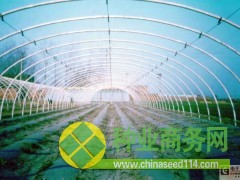經過很多(duo)學者的多(duo)年(nian)研(yan)究,也取得了(le)一定的成果。如胥(xu)芳建立了(le)一個玻璃溫(wen)(wen)室(shi)小氣(qi)候溫(wen)(wen)濕度(du)模型(xing),羅(luo)衛紅等對中(zhong)(zhong)國(guo)亞熱帶氣(qi)候不同季(ji)節條件(jian)下的溫(wen)(wen)室(shi)管(guan)理(li)和KASPRO氣(qi)候模型(xing)進(jin)行較為詳細的分析和驗(yan)證,以探索(suo)適(shi)合(he)中(zhong)(zhong)國(guo)氣(qi)候條件(jian)的Venlo型(xing)溫(wen)(wen)室(shi)氣(qi)候調控策略,汪小旵對長江中(zhong)(zhong)下游(you)地區(qu)的Venlo型(xing)溫(wen)(wen)室(shi)室(shi)內溫(wen)(wen)濕度(du)進(jin)行模擬。這些模(mo)(mo)(mo)(mo)(mo)型(xing)為中國溫(wen)(wen)室(shi)(shi)環(huan)(huan)(huan)境(jing)(jing)(jing)模(mo)(mo)(mo)(mo)(mo)型(xing)的(de)(de)(de)(de)(de)(de)研究奠定了基礎。溫(wen)(wen)室(shi)(shi)環(huan)(huan)(huan)境(jing)(jing)(jing)模(mo)(mo)(mo)(mo)(mo)型(xing)的(de)(de)(de)(de)(de)(de)用途也從最初的(de)(de)(de)(de)(de)(de)指導(dao)溫(wen)(wen)室(shi)(shi)結構(gou)設計和材(cai)料選(xuan)擇擴展到了溫(wen)(wen)室(shi)(shi)環(huan)(huan)(huan)境(jing)(jing)(jing)預測(ce)與控(kong)制(zhi)以方(fang)便溫(wen)(wen)室(shi)(shi)生產的(de)(de)(de)(de)(de)(de)管理。機理模(mo)(mo)(mo)(mo)(mo)型(xing)的(de)(de)(de)(de)(de)(de)優(you)點是模(mo)(mo)(mo)(mo)(mo)型(xing)能夠真實再現溫(wen)(wen)室(shi)(shi)中各種(zhong)環(huan)(huan)(huan)境(jing)(jing)(jing)變化的(de)(de)(de)(de)(de)(de)機理過(guo)程(cheng),模(mo)(mo)(mo)(mo)(mo)型(xing)中每個參(can)量(liang)(liang)都有(you)具體的(de)(de)(de)(de)(de)(de)物理意義,有(you)助于人們對動(dong)態過(guo)程(cheng)的(de)(de)(de)(de)(de)(de)理解,且模(mo)(mo)(mo)(mo)(mo)擬過(guo)程(cheng)較穩定,適(shi)(shi)應性(xing)較好,是系(xi)(xi)統(tong)建(jian)模(mo)(mo)(mo)(mo)(mo)的(de)(de)(de)(de)(de)(de)主要(yao)方(fang)法。然而農業(ye)的(de)(de)(de)(de)(de)(de)數字化管理系(xi)(xi)統(tong)缺(que)點是模(mo)(mo)(mo)(mo)(mo)型(xing)結構(gou)復雜(za),參(can)變量(liang)(liang)較多(duo),而且很多(duo)參(can)數一般難以確定,同時在(zai)長(chang)期的(de)(de)(de)(de)(de)(de)運行(xing)中,構(gou)成溫(wen)(wen)室(shi)(shi)的(de)(de)(de)(de)(de)(de)各種(zhong)材(cai)料由于各種(zhong)原因造成的(de)(de)(de)(de)(de)(de)腐蝕和老(lao)化也會改變其(qi)原有(you)的(de)(de)(de)(de)(de)(de)參(can)數,從而導(dao)致了建(jian)模(mo)(mo)(mo)(mo)(mo)的(de)(de)(de)(de)(de)(de)困難,或后期模(mo)(mo)(mo)(mo)(mo)擬精度(du)的(de)(de)(de)(de)(de)(de)下(xia)降。為此,一些學者開始探討根據農業(ye)的(de)(de)(de)(de)(de)(de)數字化管理系(xi)(xi)統(tong)輸入(ru)輸出數據,用系(xi)(xi)統(tong)辨識的(de)(de)(de)(de)(de)(de)方(fang)法來建(jian)立溫(wen)(wen)室(shi)(shi)環(huan)(huan)(huan)境(jing)(jing)(jing)的(de)(de)(de)(de)(de)(de)輸入(ru)輸出模(mo)(mo)(mo)(mo)(mo)型(xing)。常見的(de)(de)(de)(de)(de)(de)辨識模(mo)(mo)(mo)(mo)(mo)型(xing)主要(yao)有(you)ARX模(mo)(mo)(mo)(mo)(mo)型(xing)、神經(jing)網絡模(mo)(mo)(mo)(mo)(mo)型(xing)、模(mo)(mo)(mo)(mo)(mo)糊(hu)模(mo)(mo)(mo)(mo)(mo)型(xing)以及(ji)通(tong)過(guo)進化算法進行(xing)尋(xun)優(you)而獲得的(de)(de)(de)(de)(de)(de)模(mo)(mo)(mo)(mo)(mo)型(xing)等。這類辨識模(mo)(mo)(mo)(mo)(mo)型(xing)通(tong)常結構(gou)簡(jian)單(dan),分析方(fang)便,比較適(shi)(shi)合于溫(wen)(wen)室(shi)(shi)環(huan)(huan)(huan)境(jing)(jing)(jing)的(de)(de)(de)(de)(de)(de)控(kong)制(zhi)(如在(zai)線辨識在(zai)線控(kong)制(zhi)),但其(qi)缺(que)點是模(mo)(mo)(mo)(mo)(mo)型(xing)受特定的(de)(de)(de)(de)(de)(de)溫(wen)(wen)室(shi)(shi)結構(gou)、地理位置(zhi)和氣候條件(jian)的(de)(de)(de)(de)(de)(de)影響很大,普(pu)適(shi)(shi)性(xing)較差。
農(nong)業的數字化(hua)管(guan)理系統(tong) //www.tpwlw.com/baike/info_33.html
智慧農業 //www.tpwlw.com/
農業的數字化管理系統的研究成果






